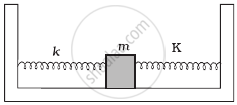Advertisements
Advertisements
Question
A mass attached to a spring is free to oscillate, with angular velocity ω, in a horizontal plane without friction or damping. It is pulled to a distance x0 and pushed towards the centre with a velocity v0 at time t = 0. Determine the amplitude of the resulting oscillations in terms of the parameters ω, x0 and v0. [Hint: Start with the equation x = acos (ωt+θ) and note that the initial velocity is negative.]
Solution 1
The displacement equation for an oscillating mass is given by:
x = `A cos (omega t + theta)`
Where,
A is the amplitude
x is the displacement
θ is the phase constant
Velocity, `v = (dx)/(dt) = -Aomega sin(omega t + theta)`
At t = 0, x = x0
x0 = Acosθ = x0 … (i)
And, `(dx)/(dt) = -v_0 = Aomegasin theta`
`A sin theta = v_0/omega` ...(ii)
Squaring and adding equations (i) and (ii), we get:
`A^2(cos^2 theta + sin^2 theta)= x_0^2 + ((v_0^2)/(omega^2))`
`:. A= sqrt(x_0^2 + (v_0/omega)^2)`
Hence, the amplitude of the resulting oscillation is `sqrt(x_0^2 + (v_0/omega)^2)`
Solution 2
x = `alpha cos (omegat + theta)`
`v = (dx)/(dt) = -aomega sin(omegat = theta)`
When t = 0, x = `x_0` and `dx/dt = -v_0`
x0 = `a cos theta`
and `-v_0 = -a omega sin theta` or a `sin theta = v_0/omega`
Squaring and adding (i) and (ii) we get
`a^2(cos^2 theta + sin^2 theta) = x_0^2 + (v_0^2)/(omega^2)`
or `a = sqrt(x_0^2 + v_0^2/omega^2)`
APPEARS IN
RELATED QUESTIONS
When the length of a simple pendulum is decreased by 20 cm, the period changes by 10%. Find the original length of the pendulum.
The phase difference between displacement and acceleration of a particle performing S.H.M. is _______.
(A) `pi/2rad`
(B) π rad
(C) 2π rad
(D)`(3pi)/2rad`
let us take the position of mass when the spring is unstretched as x = 0, and the direction from left to right as the positive direction of the x-axis. Give x as a function of time t for the oscillating mass if at the moment we start the stopwatch (t = 0), the mass is
(a) at the mean position,
(b) at the maximum stretched position, and
(c) at the maximum compressed position.
In what way do these functions for SHM differ from each other, in frequency, in amplitude or the initial phase?
The acceleration due to gravity on the surface of moon is 1.7 ms–2. What is the time period of a simple pendulum on the surface of moon if its time period on the surface of earth is 3.5 s? (g on the surface of earth is 9.8 ms–2)
Answer the following questions:
A time period of a particle in SHM depends on the force constant k and mass m of the particle: `T = 2pi sqrt(m/k)` A simple pendulum executes SHM approximately. Why then is the time
Answer the following questions:
What is the frequency of oscillation of a simple pendulum mounted in a cabin that is freely falling under gravity?
A simple pendulum of length l and having a bob of mass M is suspended in a car. The car is moving on a circular track of radius R with a uniform speed v. If the pendulum makes small oscillations in a radial direction about its equilibrium position, what will be its time period?
The relation between acceleration and displacement of four particles are given below: Which one of the particles is executing simple harmonic motion?
Two identical springs of spring constant K are attached to a block of mass m and to fixed supports as shown in figure. When the mass is displaced from equilibrium position by a distance x towards right, find the restoring force

A particle at the end of a spring executes simple harmonic motion with a period t1, while the corresponding period for another spring is t2. If the period of oscillation with the two springs in series is T, then ______.
